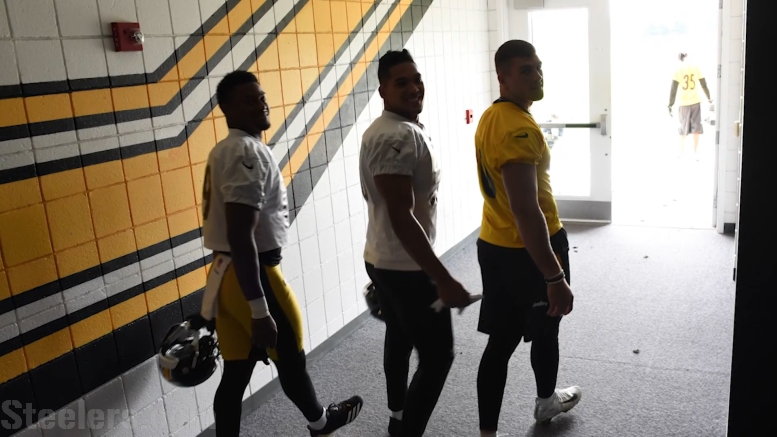Beginning May 23, I started taking detailed looks in retrospect of prior Steelers draft classes, inspired by the idea of many that draft classes can’t be fully graded until at least three years have passed. So starting with the class of three years ago, 2018, and working backward, I began fully grading every Steeler pick made, to see which picks ended up good selections, and which ones were misses.
Each of those picks was broken up into six sections, and weighted differently for players taken early, and players taken just before the draft ended and UDFA signings began. Here are those categories again, as a reminder:
Steelers’ Career: What did the player contribute to the team that drafted him?
NFL Career: Did the player make the pick look better in hindsight after leaving Pittsburgh?
Pick Value: Did the player outperform his draft slot? Did he fail to live up to the pick used on him?
Positional Value: Was the player the best player remaining at his specific position in the draft?
Other Options: Did any players go during the next round that were better selections?
Overall Grade: A final mark to denote whether the selection was an overall positive one, or one better spent elsewhere.
Finishing up the team’s 2014 Draft class reaches the initial five-draft goal this exercise began with. So before putting this series to bed and picking it back up again next May, how did all the Steelers’ selections stack up from 2014-2018?
One note before going over the rankings and other information: I did not include any picks made by the Steelers in the final two rounds who never appeared in a regular season game for the franchise. They are all missed selections, but not every sixth and seventh-rounder is expected to make a regular season roster during their careers. Players selected Rounds 1-5 are, which is why the instances of a player never making a roster from those rounds remain included. (Also, there were 11 of them, which would have filled up an entire list themselves before getting to the players who actually played for Pittsburgh).
Top 10 Picks: 2014-2018 Drafts
- T.J. Watt, OLB, Wisconsin: A+ (Round 1, Pick 30, 2017)
- Ryan Shazier, ILB, Ohio State: A (Round 1, Pick 15, 2014)
- JuJu Smith-Schuster, WR, USC: A (Round 2, Pick 30, 2017)
- Stephon Tuitt, DE, Notre Dame: A (Round 2, Pick 14, 2014)
- Javon Hargrave, DT, South Carolina State: A (Round 3, Pick 26, 2016)
- Tyler Matakevich, ILB, Temple: A (Round 7, Pick 25, 2016)
- Jesse James, TE, Penn State: A- (Round 5, Pick 24, 2015)
- Bud Dupree, OLB, Kentucky: B+ (Round 1, Pick 22, 2015)
- Cameron Sutton, CB, Tennessee: B+ (Round 3, Pick 30, 2017)
- Jaylen Samuels, TE, North Carolina State: B+ (Round 5, Pick 28, 2018)
Some very interesting results here, even if the best overall pick is a fairly obvious one. Of the top 10 picks made over those five classes, the top four come from the first two rounds. Overall, the three first-round picks (Watt, Shazier, and Dupree) are the most of any round. Multiple second, third, and fifth-round picks also appear on this list.
Shut out completely here are the fourth and sixth rounds. The highest-graded fourth-rounder taken those five years was Martavis Bryant (B grade) in 2014, and the highest sixth-rounder was Anthony Chickillo (B) in 2015. Matakevich is the only one of Pittsburgh’s six seventh-rounders to receive a positive grade, and four of the other five never played a down for the team.
The only positions to repeat were outside and inside linebacker (note: Samuels immediately converted to running back when drafted), coming as part of the team’s binge on the position those five years. It used first-round picks on linebackers three of those five drafts, and every one of them appears in the Top 10. Defensive dominates the list (23 of the 39 picks came on defense from 2014-2018) with seven of the 10 spots.
Major points to the 2017 and 2014 Drafts. The Steelers’ front office began 2017 with Watt, Smith-Schuster, and Sutton on consecutive picks, and then added James Conner (B grade) on the next one. And 2014 began with Shazier and Tuitt, and added Bryant two picks later. Those two classes help offset 2018, where Samuels is the only player to make the Top 10 list.
Their grades do not count based on a slightly different grading scale and the fact that they have yet to play their first seasons, but based on my initial grades of the 2021 class, two of the team’s 2021 picks would be Top 10 selections: Quincy Roche (A+) in the sixth round, and Dan Moore Jr. (A-) in the fourth. Additionally, Najee Harris in the first and Kendrick Green in the third (both B+) would vie for the final three spots.
Worst 10 Picks: 2014-2018 Drafts*
- Senquez Golson, CB, Ole Miss: F (Round 2, Pick 24, 2015)
- Doran Grant, CB, Ohio State: F (Round 4, Pick 22, 2015)
- Dri Archer, RB/WR/KR, Kent State: F (Round 3, Pick 33, 2014)
- Shaquille Richardson, CB, Arizona: F (Round 5, Pick 17, 2014)
- Artie Burns, CB, Miami (FL): D (Round 1, Pick 25, 2016)
- Sammie Coates, WR, Auburn: D (Round 3, Pick 23, 2015)
- Jerald Hawkins, OT, LSU: D (Round 4, Pick 25, 2016)
- Brian Allen, CB, Utah: D (Round 5, Pick 29, 2017)
- Demarcus Ayers, WR, Houston: D (Round 7, Pick 8, 2016)
- Josh Dobbs, QB, Tennessee: D+ (Round 4, Pick 28, 2017)
Again, an interesting pool of results with one foregone conclusion. Above, it was that T.J. Watt would end up the best pick overall. Here, it is that the list would be heavily decorated by cornerbacks.
The Steelers took a long, winding road to eventually reach Joe Haden, Cameron Sutton, Steven Nelson, and Mike Hilton. Along the way, they were one of the worst-drafting teams in the NFL at the position, evidenced by half this list being filled by corners, starting at the top with four of the first five. Three — Golson, Grant, and Richardson — never played a snap for the team (O.K., Grant did play exactly one), and Burns is the only first-rounder to appear on this list.
Away from the cornerback position, the same type of player largely fills the rest of this list: Those with high upside and explosive ability that they never realized in the NFL. Archer, Coates, and Hawkins all came in as good value picks with chances to be mainstays on offense, but never performed at an NFL level.
The 2015 and 2016 classes appear three times on this list. The 2016 class has the earliest miss with Burns in the first round, but the 2015 class has the one-two punch of Golson and Grant at cornerback combining for one career snap despite going as two of the first four picks (with Coates following shortly after). The 2014 and 2017 classes each appear twice, but none higher than the late third round.
Maybe the most interesting fact on this sheet to me is that, while the 2018 class had only one player on the Top 10 list, and Samuels placed 10th, the class also had no players appear on the Worst 10 list. It is a decidedly average class who isn’t quite done writing its future yet, with six different players finishing with grades between B+ and a C-.
Overall, a positive list for the Steelers, because over half the picks are Day 3 selections, where the team is not as negatively affected by a player who doesn’t stick it long in the league. There is a reason the team is lauded as one of the better-drafting franchises in the NFL. Again, the grades from 2021 do not count as stated above, but comparing them to this list, only one player would appear: Isaiahh Loudermilk in the fifth round, who bumps Dobbs out of the 10th spot with a D+.
Fun fact: I was curious to see who the exact median pick was for the Steelers from these five years, something I will do again once this exercise is completed. The Steelers made 39 picks during those five drafts. Without removing any of the sixth and seventh-rounders who never played a down for Pittsburgh, the exact median is… Sean Davis, S, Maryland, selected 58th overall in the 2016 Draft, with a C- grade.
But, considering there were 11 picks made in the final two rounds that never played for the Steelers, that threw the data off considerably. So, I figured out the two median players of the 28 other picks, and those players in the exact middle are… Terrell Edmunds, S, Virginia Tech and Daniel McCullers, DT, Tennessee. Edmunds went 28th overall in the 2018 Draft’s first round, and McCullers went 215th overall in the sixth round in 2014. Both received B- grades.
So, one final important question: How do the overall classes rank against each other? Which year did the Steelers move the franchise forward, and which did the picks yield little return?
1. 2017
- Highlights: Four starters in a row to start the draft, an MVP in T.J. Watt, modern Hines Ward in JuJu Smith-Schuster, finally hitting on a cornerback with Cameron Sutton, the James Conner story
- Misses: Lack of contributors on Day 3, spending a pick on a long snapper
This class was almost as close to perfect as a team can get in a single NFL Draft. The Steelers found starters on all four of their Day 1 and 2 picks, but those players were more than just starters. T.J. Watt is one of the greatest players in football, and easily one of the top five defenders in the game. His selection alone makes this class an excellent one. Kevin Colbert followed up with JuJu Smith-Schuster, a Pro Bowler who drew Hines Ward comps early on.
Then he doubled up in the third round, first by finally finding an elusive starting corner in Cameron Sutton, and then finishing one of the greatest stories in Pennsylvania football history by drafting James Conner, completing a journey from McDowell High School in Erie to the University of Pittsburgh to starting for the Steelers at running back and replacing Le’Veon Bell, while beating cancer along the way. Knock the 0-4 performance on Day 3 if you want, but this is the team’s best draft class since Kevin Colbert took over in 2000.
2. 2014
- Highlights: Finding prototypical Steeler star defenders with their first two picks, unearthing Martavis Bryant in the fourth
- Misses: Dri Archer washing out from the third round, Shaquille Richardson playing zero downs as a fifth-rounder
The 2014 class is up there as one of the best ones, too, again in large part because of the excellent picks to begin the year. Pittsburgh needed defensive help, and got their exact prototype inside linebacker in Ryan Shazier in the first round, and then followed that up with a borderline Pro Bowler in Stephon Tuitt along the defensive line in the second round. Tuitt is one more long-term contract from becoming a lifelong Steeler, and Shazier was on that same path before his injury. Add in uncovering a gem in Martavis Bryant to start Day 3, and a long-term backup in Daniel McCullers in the sixth, and this class is a great one. Even if three of their last five picks (including fifth-rounder Shaquille Richardson) never played an NFL down.
3. 2018
- Highlights: Late emergence from polarizing first-rounder Terrell Edmunds, a chance for Chukwuma, Jaylen Samuels’ versatility
- Misses: The Oklahoma State combo of Rudolph and Washington on offense, lack of a true high-end player
Let me be clear: Of these five classes, it is the two at the top, several tiers, and then the other three. It’s only to partially knock the classes in 2015, 2016, and 2018 — Pittsburgh just knocked it out of the park in 2014 and 2017.
The biggest weakness in the most recent class in this exercise, 2018, is that no player has stepped up as the high-end member of this class yet. Both of the classes to follow are overall weaker, but did have one player develop into a strong starter and cash in as a free agent. This class has yet to see anyone reach that level, though another year might be needed to fully grade this group.
Terrell Edmunds has polarized the fanbase since Pittsburgh reached on him in the first, but has improved every season in the league and gets to start and try to earn a big contract this year. So does Chukwuma Okorafor at left tackle, and potentially Mason Rudolph at quarterback next season. Jaylen Samuels was a nice pick, but one of these three players with an opportunity remaining needs to capitalize on it, or this class will tumble down.
4. 2015
- Highlights: Bud Dupree’s late breakout to potential Pro Bowl EDGE, Jesse James as a capable TE fill-in
- Misses: Consecutive picks in Rounds 2-4 on Senquez Golson, Sammie Coates, and Doran Grant
This class yielded a player who earned a massive contract this offseason and a tight end who started multiple years in this league. But it will be remembered in Pittsburgh for three straight strikes on Golson, Coates, and Grant, which combine for an ugly, ugly strikeout coming off the banner year of drafting in 2014. Doing his best to offset those misses is Dupree, who nearly joined them as a bust before a late breakout next to Watt allowed him to reach his potential Pro Bowl upside, and earned him a big-time contract from Tennessee as a free agent. Additional points for keeping Jesse James in-state and having him help fill the tight end spot after Heath Miller’s retirement.
5. 2016
- Highlights: Javon Hargrave becomes the starting DT in the third, Tyler Matakevich leads special teams in the seventh
- Misses: The Artie Burns/Sean Davis DB combo in Rounds 1 and 2, Jerald Hawkins in the fourth
Even with the big misses in a row at the front of the 2015 class, that year still yielded Dupree and James as starters, and Chickillo as a depth player. That tops this class, where Hargrave is the only player able to earn a long-term starting gig on offense of defense. He proved a true sleeper in the class, and Pittsburgh did well to identify a special teams warrior in Matakevich right before UDFA signings began. But this draft did little to address the major weaknesses the team had to return to Super Bowl contention.
Thank you for reading along over the course of these 39 retrospectives. Let the debate live on in the comments below. To help inspire that debate, below are all the retrospectives and final grades, sorted by year.
| 2018 Draft | Grade |
|---|---|
| Round 1: Terrell Edmunds, S, Virginia Tech | B- |
| Round 2: James Washington, WR, Oklahoma State | C- |
| Round 3: Mason Rudolph, QB, Oklahoma State | C- |
| Round 3: Chukwuma Okorafor, OT, Western Michigan | C+ |
| Round 5: Marcus Allen, S, Penn State | B- |
| Round 5: Jaylen Samuels, TE, North Carolina State | B+ |
| Round 7: Joshua Frazier, DT, Alabama | F |
| 2017 Draft | Grade |
|---|---|
| Round 1: T.J. Watt, OLB, Wisconsin | A+ |
| Round 2: JuJu Smith-Schuster, WR, USC | A |
| Round 3: Cameron Sutton, CB, Tennessee | B+ |
| Round 3: James Conner, RB, Pitt | B |
| Round 4: Joshua Dobbs, QB, Tennessee | D+ |
| Round 5: Brian Allen, CB, Utah | D |
| Round 6: Colin Holba, LS, Louisville | F |
| Round 7: Keion Adams, OLB, Western Michigan | F |
| 2016 Draft | Grade |
|---|---|
| Round 1: Artie Burns, CB, Miami (FL) | D |
| Round 2: Sean Davis, S, Maryland | C- |
| Round 3: Javon Hargrave, DT, South Carolina State | A |
| Round 4: Jerald Hawkins, OT, LSU | D |
| Round 6: Travis Feeney, OLB, Washington | F |
| Round 7: Demarcus Ayers, WR, Houston | D |
| Round 7: Tyler Matakevich, ILB, Temple | A |
| 2015 Draft | Grade |
|---|---|
| Round 1: Bud Dupree, OLB, Kentucky | B+ |
| Round 2: Senquez Golson, CB, Ole Miss | F |
| Round 3: Sammie Coates, WR, Auburn | D |
| Round 4: Doran Grant, CB, Ohio State | F |
| Round 5: Jesse James, TE, Penn State | A- |
| Round 6: Leterrius Walton, DT, Central Michigan | C |
| Round 6: Anthony Chickillo, OLB, Miami (FL) | B |
| Round 7: Gerod Holliman, S, Louisville | F |
| 2014 Draft | Grade |
|---|---|
| Round 1: Ryan Shazier, ILB, Ohio State | A |
| Round 2: Stephon Tuitt, DE, Notre Dame | A |
| Round 3: Dri Archer, RB/WR/KR, Kent State | F |
| Round 4: Martavis Bryant, WR, Clemson | B |
| Round 5: Shaquille Richardson, CB, Arizona | F |
| Round 5: Wesley Johnson, OL, Vanderbilt | C |
| Round 6: Jordan Zumwalt, ILB, UCLA | F |
| Round 7: Daniel McCullers, DT, Tennessee | B- |
| Round 7: Rob Blanchflower, TE, UMass | F |








